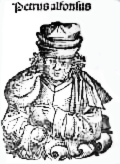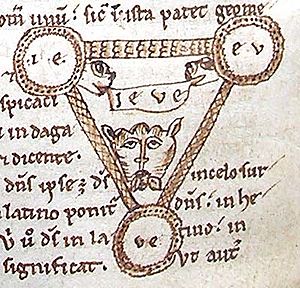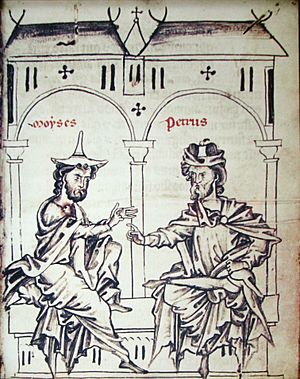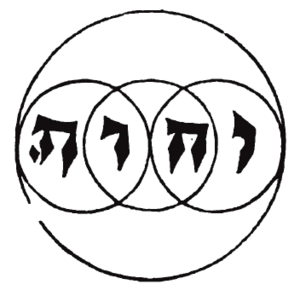Petrus Alphonsi facts for kids
Petrus Alphonsi (who died sometime after 1116) was a smart person from Spain. He was a Jewish physician (doctor), writer, astronomer (someone who studies stars), and a polemicist (someone who argues strongly about beliefs). He became a Christian in 1106.
He is also known as Alphonsi, Peter Alfonsi, or Peter Alphonso. His birth name was Moses Sephardi. He was born in a part of Spain ruled by Muslims, but after he became a Christian, he lived mostly in England and France.
Contents
Life Story
Petrus Alphonsi was born in the 11th century in Spain, but we don't know the exact date or place. He grew up and studied in al-Andalus, which was a Muslim part of Spain.
He wrote that he was baptized (a Christian ceremony) in a city called Huesca on June 29, 1106. This was on St. Peter's Day, and he was probably middle-aged by then. To honor Saint Peter and his royal supporter, King Alfonso I of Aragon, he took the name Petrus Alfonsi. This means "Peter, Alfonso's (man)."
By 1116, he had moved to England and stayed there for several years. Later, he moved to northern France. We don't know when he died. He was very famous as a writer during his lifetime and throughout the Middle Ages. More than 160 copies of his books still exist today.
His most famous works are:
- Dialogi contra Iudaeos (Dialogue Against the Jews): This book is an imaginary talk between a Jewish person and a Christian.
- Disciplina Clericalis (A Training-school for the Clergy): This is a collection of stories and fables from the East.
Petrus grew up Jewish in al-Andalus. After he became well-known, he converted to Christianity. This background gave him a special understanding of Christianity, Judaism, and Islam. This knowledge was very helpful when he wrote his arguments about different faiths.
According to a historian named John V. Tolan, Petrus Alfonsi's writings were very popular. He became an "auctor," meaning an expert that people would quote. His success came from his ability to connect different cultures. He was a Jew from the Muslim world who then lived in Christian Europe. His deep knowledge of these religions made him unique.
Petrus's early life happened during a time of change and political problems in Spain. Judaism was facing new scientific ideas, and both Islam and Christianity were growing in influence. This mix of cultures and ideas helped shape his writings.
In his book Dialogus, Alphonsi said he traveled to England as a magister (a master) in liberal arts. He worked for several years as the court doctor for Henry I of England (who ruled from 1100 to 1135).
Petrus Alfonsi's presence in England might have helped new ideas about Arabic science spread there. He talked about astronomy with a scholar named Walcher of Malvern. Petrus shared the Arabic way of studying the stars. They might have even worked together on a book about eclipses.
His Works
Disciplina Clericalis
Alphonsi is most famous for a collection of 33 stories. He wrote them in Latin in the early 1100s. This book is a group of moral stories from the East, which he translated from Arabic.
Some of his stories came from tales that later appeared in Arabian Nights. These include parts of the "Sindibad the Wise" story cycle and "The Tale of Attaf". His book helped set up a style of teaching through stories that many other writers used in the Middle Ages.
This collection was very popular and is important for studying how stories travel between cultures. It was called Disciplina Clericalis (A Training-school for the Clergy). Clergymen (religious leaders) often used these stories in their talks, even though some had questionable morals. The book helps us understand how fables spread. It was translated into French, Spanish, German, and English.
Dialogi contra Iudaeos
Like many people who changed their religion at that time, Alphonsi was sometimes criticized by his former Jewish community. To respond to this and show his strong belief in his new faith, he wrote a book called Dialogi contra Iudaeos (Dialogue Against the Jews). This book explained his Christian beliefs and challenged some Jewish ideas.
This book became one of the most widely read and used texts in the Middle Ages for discussing differences between Christianity and Judaism. Alphonsi wrote the Dialogues in 1110. He presented it as a debate between his old self, Moses (who was Jewish), and his new self, Peter (who was Christian).
The book has twelve "Dialogues" or chapters. The first four discuss Judaism, the fifth discusses Islam, and the last seven explain and defend Christianity.
Before Alfonsi's Dialogi contra Iudaeos, Christians often followed a tradition that allowed some tolerance towards Jewish people. Most attacks on Jewish beliefs were local and not very organized. There wasn't a widely used book that challenged Judaism as a whole until Alphonsi's Dialogi.
Alfonsi tried to show that Christianity was true by discussing what he saw as problems in Judaism. He faced a challenge because Christianity's basic ideas come from the Old Testament, which is also part of Jewish scripture. He tried to solve this by focusing his arguments on the Talmud (a collection of Jewish teachings) and the rabbis (Jewish teachers).
His work presented a new idea. Before him, some Christians believed that Jews were simply following the Old Law (the laws of Moses) without understanding that Jesus had fulfilled them. Petrus Alfonsi suggested a different idea: that "the Jews no longer followed the Old Law; they follow a new and different law, that of the Talmud." He believed that Jewish leaders were purposely misleading their people.
This new idea was very different from earlier Christian discussions. Before, Christians often tried to prove Christianity by pointing to parts of the Old Testament that they believed showed Jesus was the Son of God. This view suggested that Jews would eventually see the truth and become Christians. Petrus's new idea, however, claimed that Jewish leaders were knowingly hiding the truth. This created new tensions between Christians and Jews.
The older tradition assumed that Jews would eventually convert to Christianity. But when many Jews did not convert, people looked for new explanations. Alfonsi tried to explain this by saying that Judaism was different from what God intended, and that Jewish leaders had knowingly hidden the truth. He focused his arguments on the religion and its leaders, not on all Jewish people. He did this by pointing out what he saw as scientific problems in Jewish beliefs.
Alfonsi's book did not immediately cause violence between religions. At that time, the older tradition of tolerance mostly continued. However, his work did provide new ways of thinking and new language that later writers used to make stronger claims against Judaism.
Before Alfonsi's Dialogi contra Iudaeos, many Christians in Europe knew very little about the religious beliefs and practices of Jews living in their own cities. Most Christians didn't know what the Talmud contained, or even that it existed. This lack of knowledge made it hard for Christians to discuss Judaism.
What made Petrus Alfonsi's work special was his deep knowledge of Judaism, combined with his new way of looking at it. Because he grew up in Iberia (Spain), where people often discussed different religions, he brought his firsthand knowledge of Judaism to Christian Europe. This changed how people discussed religious differences.
The Dialogi contra Iudaeos marked a turning point in how people discussed and viewed Judaism. In the Dialogi, Alfonsi argued with himself, as his old Jewish self (Moses) and his new Christian self (Peter). This way of arguing was very powerful because he could control both sides of the discussion. Since he had been both Jewish and Christian, he could present both viewpoints accurately. By arguing against himself, he could set the rules of the debate without any surprises from a real second person. This made his arguments seem very strong and influential.
The discussions between Moses and Peter in the book seemed friendly, but the arguments were a new way to challenge Judaism. They were more negative than many earlier Latin books. Alfonsi saw Judaism as a group that was against Christianity. He claimed that Judaism followed the Old Law "only in part, and that part is not pleasing to God." He also argued that Jewish leaders killed Jesus out of envy. He said that "God revealed to their priests the Temple would be destroyed and the Jews scattered as punishment for the Crucifixion; the priests, out of malice and envy, hid this revelation from their people."
This was a clear change from the older tradition of tolerance. It was successful because Petrus Alfonsi was a Jewish convert. His knowledge of the Talmud and Judaism, which was new for Christian writers, made his arguments seem very strong. This led some people to question the long-standing tradition of tolerance. This created new challenges for Jewish communities.
Arguments in the Dialogi contra Iudaeos
One of Alfonsi's most damaging claims for Jewish-Christian relations was that Jews knew Jesus was the Son of God but still killed him. Historian John Tolan says that "Alfonsi was the first Latin writer... to say that the Jews were guilty of deicide" (meaning killing God). In the tenth chapter of the Dialogi contra Iudaeos, Alfonsi states "that Christ was crucified and killed by the Jews of their own free will." He claimed that Jewish leaders were dishonest, and because he used to be a Jew who followed Rabbinical Judaism, he felt he could reveal their way of thinking.
When Jews were accused of killing the Son of God, Moses (in the dialogue) gave three reasons to explain this. First, he said the Crucifixion was necessary to "fulfill his will." Second, he argued that many Jewish ancestors were not involved and lived elsewhere; he said Judah killed Christ, not all of Israel. Third, Moses claimed Jews had a right to kill him because they believed Jesus was a magician. Peter then gave stronger counter-arguments. Moses eventually agreed that Peter made good points. Moses then asked why Jews, known for their wisdom, would kill Jesus. Peter replied that "since they denied him and slew him from envy, this is why they are guilty of such a great crime." He said they killed Christ "not in order to fulfill his will, but from the poison of hatred and envy."
Earlier writers had said that the exile of the Jews was due to the Crucifixion. But what was new was the idea that at least some rabbis knew Jesus was the Son of God before they killed him, and that these rabbis also knew this was why they were in exile.
Petrus's arguments, though about Judaism, did not try to attack all Jewish people. He focused his arguments on the rabbis and their writings. This is interesting because his arguments suggested that Jewish people were not stubbornly wrong, but rather misled by envious rabbis who wanted to keep power. If this were true, then Christians might hope that Jews could convert.
This idea that Jews could convert if they just learned the truth about the rabbis did not immediately harm Jews. However, over time, these ideas changed the way Christians thought about Judaism. They provided the language that later Christians used to try to force Jews to convert. Christians believed that once Jews discovered the truth that Alfonsi presented, they would convert because the truth would be obvious. But this did not happen. While he succeeded in changing how Christians viewed Jews, it did not lead to conversions, but rather to more persecution of Jews, which he was against.
When Alfonsi used the Talmud in his arguments, his goal was to show that it was "not from God" and that it went "against logical and scientific fact." He used the Talmud differently from how Christians had used it before. Earlier Christians would just look for parts in the Talmud that seemed to insult Jesus to make Christians dislike Jews. Petrus Alfonsi ignored such insults. Instead, he focused on parts that he believed went against philosophy or science. For example, he discussed how the idea of God having a physical body (which he said some Talmudic rabbis believed literally) went against the scientific ideas of his time. He attacked a mystical Jewish tradition called Shi’ur Qomah, trying to show that it contradicted the science of his day.
The Fifth Titulus
As mentioned, Alfonsi was unique because he was born Jewish in al-Andalus and then converted to Christianity. He had a great understanding of Christianity and Judaism, but he also knew a lot about Islam. He was the first Christian writer to have such a good knowledge of the Islamic faith. Some scholars believe that Alfonsi's arguments against Islam were not just to disprove it, but also to use Islam as a way to challenge Judaism for Christian readers. This doesn't mean it was his only goal, but it was an important one.
At the start of the fifth chapter, Petrus made it clear that he knew a lot about Islam. He wanted his readers to know he was an expert on the topic. Since there weren't many detailed arguments against Islam at that time, it was important for him to show his authority. He even said he was "not less convincing than if Mohammad himself were present..." This confidence allowed his Dialogi to influence how Christians in Europe viewed Islam.
The fifth chapter of the Dialogi contra Iudaeos focused on arguments against Islam. It was the only one of the twelve chapters that mentioned Islam. Some historians think it was shorter because he only needed to convince a Jewish person (in the dialogue) that Islam was not valid. However, others argue that it was written to connect Judaism with Islam in the minds of Christian readers. The fact that Petrus had Moses (the Jewish character) defend Islam made it an argument against Judaism. The Dialogi was written for Christians to read, not Jews. It was a very important book for shaping how Christians viewed Judaism. By showing Judaism defending Islam, Petrus could, by association, suggest that Judaism was also not valid if Islam was not.
If Petrus truly wanted to make a full argument against Islam, he could have written a separate book about it. It seems strange to put one short chapter about Islam in the middle of a long book mainly about Judaism. If the fifth chapter's main purpose was to disprove Islam, it doesn't fit with the rest of the book.
When you compare Alfonsi's arguments against Judaism to his arguments against Islam, you learn a lot about his thoughts on each religion. His arguments against Judaism didn't focus on how the religion started or its first followers. But that's exactly how Alfonsi tried to criticize Islam. He used a different method to challenge Judaism by connecting it with Islam for Christians.
At the beginning of the fifth chapter, Moses (the Jewish character) agreed that Peter didn't like Judaism, but then suggested that Islam was a good religion and better than Christianity. Moses said, "Indeed [their] law is generous. It contains many commands concerning the pleasures of this present life, by which fact divine love is shown to have been greatest toward them... If you should investigate the basis of this law, you will find that it is grounded on an unshakable foundation of reason." Petrus wanted Moses to defend Islam. This was important because he wanted his readers to strongly link Judaism and Islam. His goal was to make readers think that Judaism and Islam were working together against Christianity.
Alfonsi never directly said this, but he wanted his readers to believe that Christianity was right. He wanted them to think that other religions would work together to oppose Christianity rather than admit Christianity was true. He wanted readers to believe that Judaism was only interested in disproving Christianity and would even defend Islam if needed. This was effective because the readers were Christians, and they would assume that all "false" religions would work together to bring down Christianity.
By putting Judaism on the same level as Islam, Alfonsi helped strengthen his argument that Judaism was not what God intended. Before, Judaism had a certain level of tolerance. But by linking it with Islam, he made Judaism seem as different from Christianity as Islam was.
This link between Judaism and Islam might not have been as directly harmful as Alfonsi's claims that Judaism was wrong, but it did damage how Judaism was seen. Alfonsi also tried to make the Arabs and the origins of Islam seem bad to dismiss Islam as invalid. He said that "the greater portion of the Arabs at that time were common soldiers and farmers, and almost all were idolaters, except for some who embraced the law of Moses in a different way..." He also said of Muhammad that, "Once he was transformed from the humblest pauper into a very rich man by this wealth, he burst forth into such arrogance that he expected that the kingdom of the Arabs would be offered to him..." These suggestions about Arabs being idol worshipers and Muhammad being arrogant were meant to disprove the Islamic faith. Petrus could criticize Islam's history in a way he couldn't with Judaism because Christianity doesn't base its faith on Islam. This was to show Christian readers that there was no reason to defend Islam, and anyone who did must be trying to undermine Christianity.
While we can't prove it with facts, some historians believe that Petrus Alfonsi truly believed Christianity was right and converted for honest reasons. His life story might suggest he converted for opportunities, but when you read his Dialogi contra Iudaeos, it seems he deeply believed what he wrote. He thought that all Jews just needed to see the truth and that the rabbis were lying to keep people under their control. He saw himself in the Jews, believing that as long as they were led by dishonest rabbis, they had no reason to convert.
This idea was his biggest weakness when writing the Dialogi. Even though he wrote it for Christians, he wanted it to help Christians understand why Jewish people were not converting. According to Alfonsi, as long as the rabbis stayed in power, they could stop Jewish people from seeing the truth. Alfonsi's Dialogi was the most important book for changing how Christians viewed Jews. He thought his work would lead to conversions. But this was not the case. While he succeeded in changing Christian mindsets towards Jews, it did not lead to conversions. Instead, it led to more persecution of Jews, which was something he was against.
A copy of his work from the 12th century can be found at the Cambridge Historic Parker Library.
Other works
- De dracone: In this book, he calculated how stars move.
- De Astronomia: This book has an astronomical chart based on Arab, Persian, and Latin calendars. With these charts and an astrolabe (an old tool), people could accurately find the positions of the sun, moon, and the five known planets.
- Carta a los peripatéticos franceses (Letter to the French Peripatetics).
See also
 In Spanish: Pedro Alfonso para niños
In Spanish: Pedro Alfonso para niños
- Jacob ben Reuben (rabbi)
|





